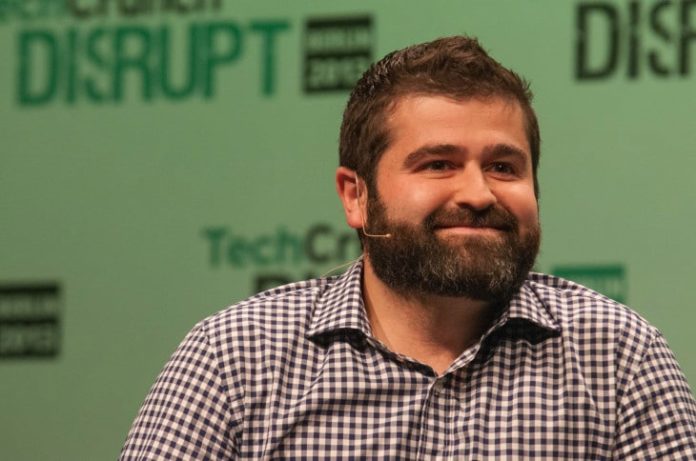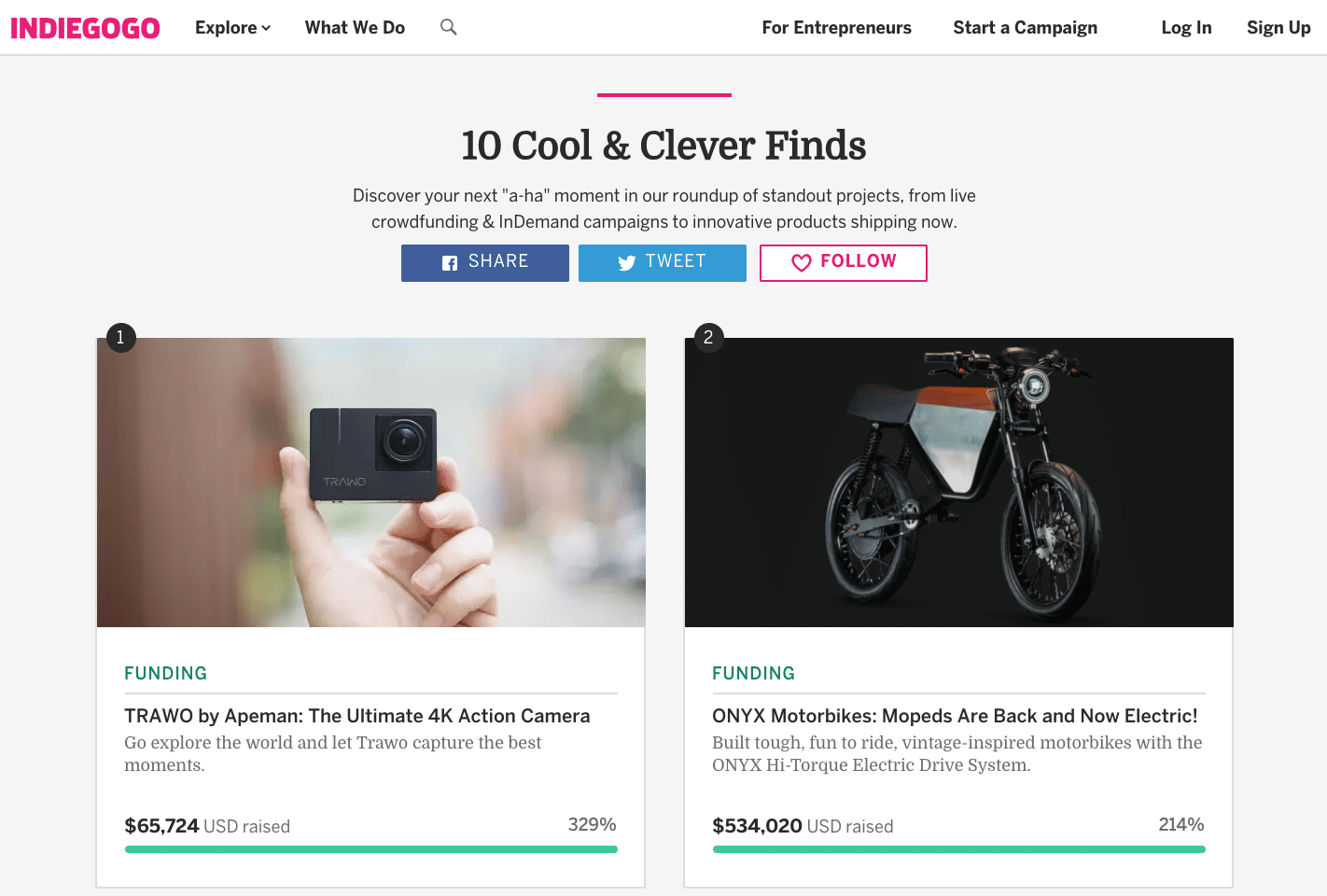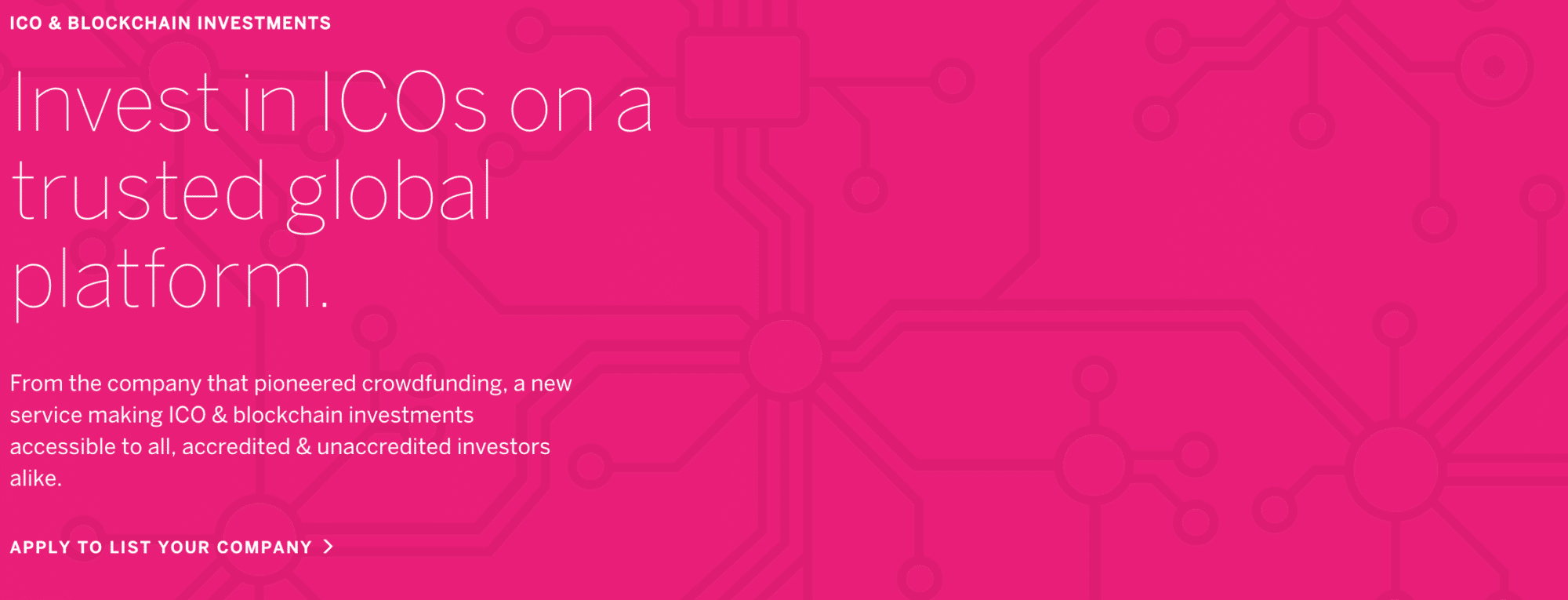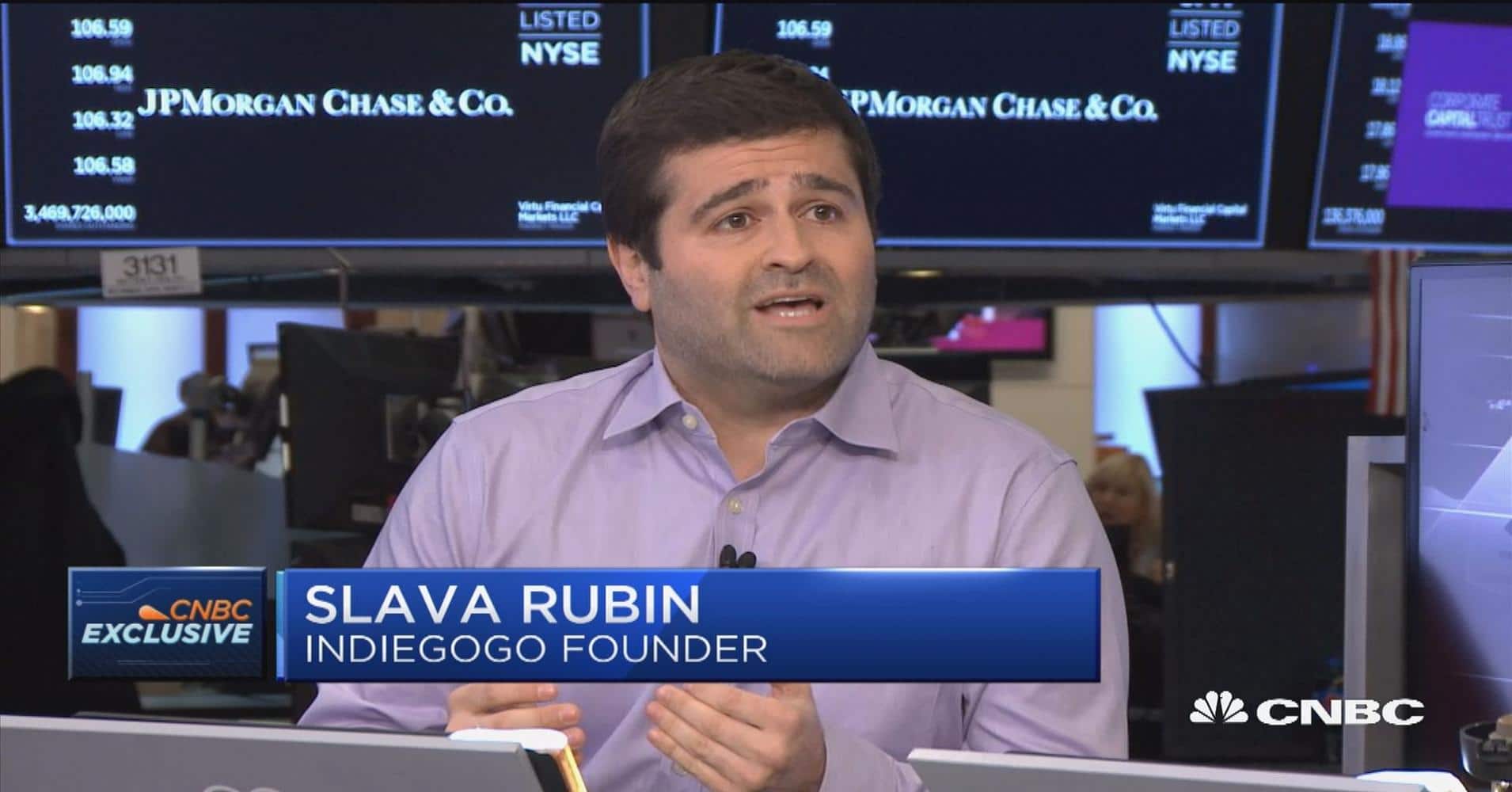
When it comes to crowdfunding, few people have as keen insights rooted in deep experience as the Founder of Indiegogo, Slava Rubin.
Founded in 2008 during the middle of one of the worst financial crises the United States has seen, Indiegogo aimed to change how startups raised capital. Up until that point, fundraising consisted of the traditional circuit of family & friends, angel investors, private equity, or venture capital. Someone with a great idea for a product had to take on the enormous risk of securing funding themselves while also attempting to bring their dreams into reality.
Slava Rubin, image via TechCrunch
In December 2017, Indiegogo announced that they are adding ICOs and blockchain investments on their platform. With an estimated $4.9 billion raised by ICOs in 2017, it seems like a natural decision for one of the world’s largest crowdfunding platforms.
However, Indiegogo’s venturing into ICOs is more than just strategy. The ethos that Indiegogo and the cryptocurrency community were founded on is essentially the same: a decentralized “power of the people” to play an active role in deciding on how they want the world to be.

With thousands of innovative product ideas, Indiegogo has taken the concept of crowdfunding and made it fun, interactive, and mainstream. Now, they’re aiming to further legitimize and popularize ICOs.
One of the core components of Indiegogo’s strategy is to help projects follow regulations by registering them as securities (in applicable cases). Starting small, small investors on Indiegogo will only be able to invest $10,000 in most projects, and projects won’t be able to raise more than $1 million due to restrictions from the 2012 JOBS Act.
We had a chance to chat with Slava Rubin about crowdfunding, ICOs, and the evolution of the fundraising space.
What’s it like going into the ICOs from crowdfunding? What are some of the biggest challenges you’ve seen?
We see this all as a natural evolution of what we were looking to accomplish as Indiegogo from the beginning. We came up with the idea in 2006 and launched in 2008 to democratize access to capital.
At the time it was hard to use the Internet to be able to get the crowd to fund you. It was really all about the gatekeeper, knowing the right VC, knowing the right banker, knowing the right person at government organizations.
So we started with a perks-based model. We wanted to be able to do equity crowdfunding right away, but because of the Securities Act of 1933 and regulations, we weren’t allowed to.
Then fast forward to 2012. We were able to help pass the JOBS Act with President Obama, and then in 2016 in the US, finally equity crowdfunding went live. So we could do our crowdfunding techniques that offered people financial return.
In parallel, blockchain was advancing forward and bitcoin was becoming more mainstream. Then ICOs started coming out right after equity crowdfunding. What was interesting is we started getting a lot of interest from various ICOs and blockchain-oriented fundraisers asking can they use our platform or our capabilities to be able to raise money. So for us, this is a natural evolution of trying to accomplish our vision.
In the early days, I would call what we did crowdfunding 1.0 which was a perks-based model and then 2.0 which was a vanilla equity model. Now you could almost consider a 3.0 where it’s a blockchain-based investment model. So that’s how we’ve evolved.
What’s the difference for someone who is investing in a project receiving products in return or equity in return versus someone who’s investing in a project for tokens?
I think the way you should look at it is the perks model which is no financial return. It’s all about backing a person. We don’t even use the word investing for backing a person or pre-ordering a product, validating an idea. That’s more about wanting to support the person, wanting to get the good, or just being part of a movement.
When you look at equity crowdfunding or any of these blockchain raises, it’s often more about wanting to participate in the financial upside, whether it’s revenue share or getting a piece of the company. So it’s a little bit different of analysis. It’s not about so much the individual or getting a product. As it relates to vanilla equity or these blockchain offerings, I think they’re very similar in terms of the analysis. It’s like if I put a dollar in, is it a good investment? Will I get more than a dollar out? Obviously, there are different types of organizations and you need to research it appropriately, but I think the analysis is pretty similar.
The explosion of ICOs in 2017 cooled down a bit this year. The length of time between projects doing a private presale and a public ICO is decreasing, and some projects don’t even ICo at all. How do you guys plan on evolving with the space?
So 2017 definitely had a lot of activity. There was an uncertain regulatory environment and the various issuers didn’t exactly know how they needed to navigate it, but there weren’t clear rules or challenges back, so there was a lot of activity. In Q1 of 2018, the SEC and FINRA clearly messaged that all these issuers need to make sure they’re doing things by the book and a lot of them potentially are securities as opposed to avoiding the securities exemption.

As part of that, a lot of issuers in the United States had to rethink their approaches and yes, some of them have limited their public sales and gone more with a private mode. We have done that as well to ensure that we’re staying within regulations. So we do have some private offerings as well as other offerings that are clear security tokens and are able to comply with the securities exemption so they can be public whenever they decide.
Could you tell us a little bit about what ICOs have gone through Indiegogo so far? The Fan Controlled Football League (FCFL) has been pretty successful with the platform.
They were the first organization that was looking to raise with us. Since then you’ve got a massive amount of inbound, whether it’s on the issuer side as well as on the investor side. Also, there’s been large enterprises that we’re now working with as well. We actually do have some other offerings that are in various stages of private raising right now before they go public. Again, those aren’t public so we’re not discussing them.
What’s the vetting process look like for the ICOs that you host on the platform? Because there are a lot of more shady projects out there. How do you guys weed out the quality from the crap?
The perks model is very open. We have hundreds of thousands of entrepreneurs that use the original Indiegogo. Then when we launched in late 2016 with our equity-based model, we definitely had to revisit that because as part of having a regulated portal, we had to make sure that we were doing all the right diligence to ensure against fraud and other challenges.
So we actually have less than 2% of the companies that apply actually get listed right now on the equity portal. We have the highest average raise because we’re doing such a good job of filtering through the noise and making sure that we’re having high integrity companies.
Most of the companies, not quite hundred percent, but most of the companies of the over 50 companies that have raised on Indiegogo, have hit their minimum targets, which should show that if you get picked by Indiegogo to be able to raise, that it’s going to be a pretty good result for you.

Slava Rubin (sans beard) via CNBC)
Now that’s on the vanilla equity fund. We’ve used many of those same techniques in terms of diligence and then moved that over to the blockchain offerings. A lot of the research is very similar. It’s about the team, it’s about the business model, what’s the financial position, what are the expected results, things like that.
Obviously, there’s different nuance related to evaluating the tech, evaluating the token economics, and all those things are different than vanilla equity. We factor that in towards the diligence process. Again, the ratio of companies that end up raising with us versus applying is well below 2%.
How would you say that ICOs are behaving differently in the US compared to Europe, Asia, Africa, etc.?
It definitely depends. Each region I think is different, but the US definitely is taking a more conservative approach as it relates to being public with your offerings. I think that’s why since Q1 you see some of these ICOs going a little bit more private with their promotion as well as looking a little bit more international over their exposure.
Do you have any favorite projects in this space that haven’t necessarily gone through Indiegogo?
I think there are lots of great companies. I think that it’s very early. I think right now there’s a lot of people that are still focused a lot on the tech. I think it will be great once there is a lot more consumer-facing application and usage.
Right now there’s still a lot of investment into the software being built. I’m looking forward to the consumers actually using the software without even noticing it.
I’m also looking forward to the point where entrepreneurs stop using blockchain as a buzzword and just realize it’s just a technology.
Exactly. It’s like saying, “Oh I’m using the Internet.”
Amazon is cool, Facebook is cool, YouTube is cool; the Internet itself is not cool by itself.
What industries are you most excited to see a change in whether it’s blockchain or some combination of blockchain and whatever the next combination it’s going to be?
That’s like asking me what am I excited about the Internet changing. I think blockchain has the opportunity to change every industry, it’s just a matter of timing. Some will move faster than others.
Which ones do you think will be the first to really see rapid change?
I think anywhere where there’s a transaction, which there are lots of places where there are transactions, whether it’s Fintech or marketplaces, supply chain, logistics, identity; anywhere where you need to track the integrity of the transaction. When you’re moving hands on a diamond, or on your coffee, or your fish, or your iPhone, anything short of the integrity of it is what it is. I think there’s a lot of opportunities across the supply chain, across Fintech, ensuring that transactions happen on time in the right place, it’s not fraudulent. Compliance, identity.
You once said that every project deserves the opportunity to fail, which I think is a very keen insight that can be applied to the ICO world. Not necessarily a question, just rambling on my end. But good quote, I love it.
Thank you.
How can someone reading this help Indiegogo’s venturing into the ICO world succeed?
We’re a classic marketplace, so either of the two sides. If there’s people in your audience who are looking to raise money and want to explore how best to navigate all the regulations, and how best to turn them and the public audience into investors, we’re happy to work with them.
We’re one of the only platforms out there that has 10 years of experience, has a broker dealer in-house, and has really strong relationships with regulators with a proven track record. So we’re happy to work on the issuer side. We’re also very keen to continue to build up our investor book. If people are interested in learning more about our opportunities of what they can invest in, they can obviously go onto the site.
If people want, they can even email me, Slava@Indiegogo on either side of the marketplace, and I’ll make sure to talk to them.
Well all right, Slava. I appreciate your time. Have a great rest of your day.
You too.
_____
Interview conducted by Alex Moskov and Steven Buchko.
The post Indiegogo’s Founder Slava Rubin on Crowdfunding and ICOs appeared first on CoinCentral.

Coincentral.com is author of this content, TheBitcoinNews.com is is not responsible for the content of external sites.
Our Social Networks: Facebook Instagram Pinterest Reddit Telegram Twitter Youtube











